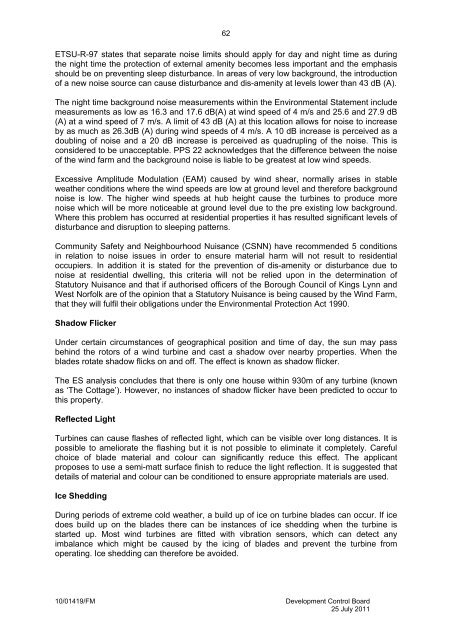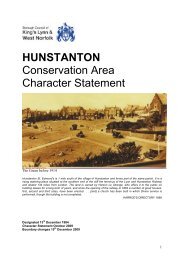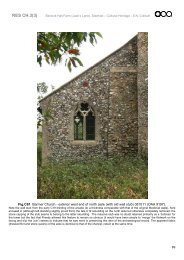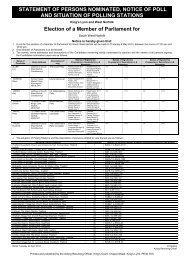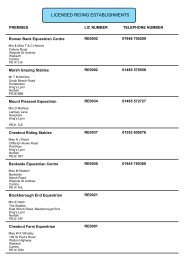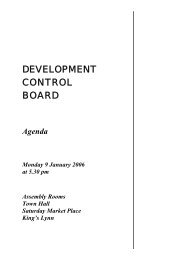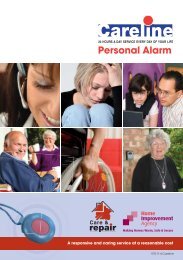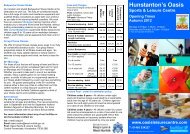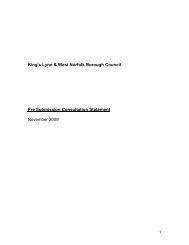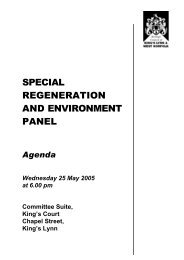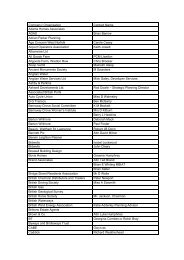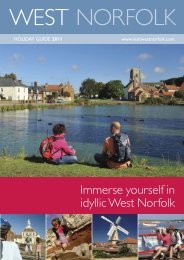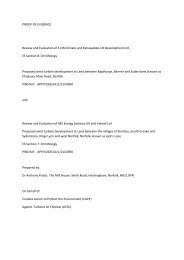11/00713/F - Borough Council of King's Lynn & West Norfolk
11/00713/F - Borough Council of King's Lynn & West Norfolk
11/00713/F - Borough Council of King's Lynn & West Norfolk
Create successful ePaper yourself
Turn your PDF publications into a flip-book with our unique Google optimized e-Paper software.
ETSU-R-97 states that separate noise limits should apply for day and night time as during<br />
the night time the protection <strong>of</strong> external amenity becomes less important and the emphasis<br />
should be on preventing sleep disturbance. In areas <strong>of</strong> very low background, the introduction<br />
<strong>of</strong> a new noise source can cause disturbance and dis-amenity at levels lower than 43 dB (A).<br />
The night time background noise measurements within the Environmental Statement include<br />
measurements as low as 16.3 and 17.6 dB(A) at wind speed <strong>of</strong> 4 m/s and 25.6 and 27.9 dB<br />
(A) at a wind speed <strong>of</strong> 7 m/s. A limit <strong>of</strong> 43 dB (A) at this location allows for noise to increase<br />
by as much as 26.3dB (A) during wind speeds <strong>of</strong> 4 m/s. A 10 dB increase is perceived as a<br />
doubling <strong>of</strong> noise and a 20 dB increase is perceived as quadrupling <strong>of</strong> the noise. This is<br />
considered to be unacceptable. PPS 22 acknowledges that the difference between the noise<br />
<strong>of</strong> the wind farm and the background noise is liable to be greatest at low wind speeds.<br />
Excessive Amplitude Modulation (EAM) caused by wind shear, normally arises in stable<br />
weather conditions where the wind speeds are low at ground level and therefore background<br />
noise is low. The higher wind speeds at hub height cause the turbines to produce more<br />
noise which will be more noticeable at ground level due to the pre existing low background.<br />
Where this problem has occurred at residential properties it has resulted significant levels <strong>of</strong><br />
disturbance and disruption to sleeping patterns.<br />
Community Safety and Neighbourhood Nuisance (CSNN) have recommended 5 conditions<br />
in relation to noise issues in order to ensure material harm will not result to residential<br />
occupiers. In addition it is stated for the prevention <strong>of</strong> dis-amenity or disturbance due to<br />
noise at residential dwelling, this criteria will not be relied upon in the determination <strong>of</strong><br />
Statutory Nuisance and that if authorised <strong>of</strong>ficers <strong>of</strong> the <strong>Borough</strong> <strong>Council</strong> <strong>of</strong> Kings <strong>Lynn</strong> and<br />
<strong>West</strong> <strong>Norfolk</strong> are <strong>of</strong> the opinion that a Statutory Nuisance is being caused by the Wind Farm,<br />
that they will fulfil their obligations under the Environmental Protection Act 1990.<br />
Shadow Flicker<br />
Under certain circumstances <strong>of</strong> geographical position and time <strong>of</strong> day, the sun may pass<br />
behind the rotors <strong>of</strong> a wind turbine and cast a shadow over nearby properties. When the<br />
blades rotate shadow flicks on and <strong>of</strong>f. The effect is known as shadow flicker.<br />
The ES analysis concludes that there is only one house within 930m <strong>of</strong> any turbine (known<br />
as ‘The Cottage’). However, no instances <strong>of</strong> shadow flicker have been predicted to occur to<br />
this property.<br />
Reflected Light<br />
Turbines can cause flashes <strong>of</strong> reflected light, which can be visible over long distances. It is<br />
possible to ameliorate the flashing but it is not possible to eliminate it completely. Careful<br />
choice <strong>of</strong> blade material and colour can significantly reduce this effect. The applicant<br />
proposes to use a semi-matt surface finish to reduce the light reflection. It is suggested that<br />
details <strong>of</strong> material and colour can be conditioned to ensure appropriate materials are used.<br />
Ice Shedding<br />
During periods <strong>of</strong> extreme cold weather, a build up <strong>of</strong> ice on turbine blades can occur. If ice<br />
does build up on the blades there can be instances <strong>of</strong> ice shedding when the turbine is<br />
started up. Most wind turbines are fitted with vibration sensors, which can detect any<br />
imbalance which might be caused by the icing <strong>of</strong> blades and prevent the turbine from<br />
operating. Ice shedding can therefore be avoided.<br />
10/01419/FM Development Control Board<br />
25 July 20<strong>11</strong><br />
62


